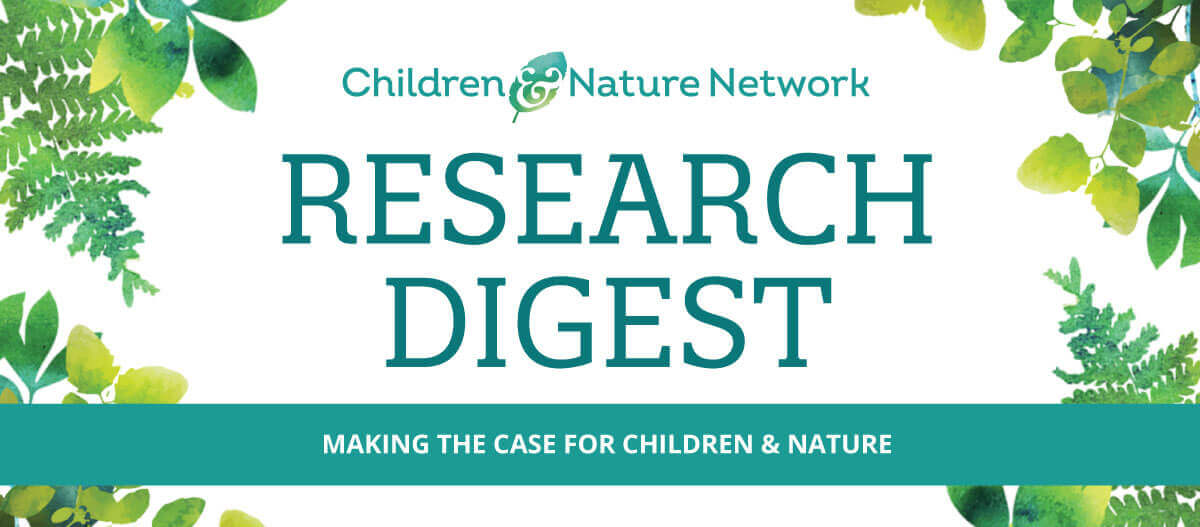Benefits of Family-Based Nature Engagement
The benefits of children and parents/caregivers experiencing nature together include (1) improved communication and stronger bonds between family members, (2) deeper appreciation of family traditions and cultural heritage, and (3) stronger and sustained connectedness to nature.
Mothers and daughters find spending time outdoors together strengthens communication and family connectedness
Interviews with 26 mothers and daughters (age 10-12) in the U.S. indicated that the benefits of family-based nature activities — in addition to promoting positive individual health outcomes — support increased well-being for families. The family benefits include improved communication between family members and members getting along better with each other.
Izenstark & Ebata, 2019. Why families go outside: An exploration of mothers’ and daughters’ family-based nature activities.
Childhood family-based nature activities are positively linked to early adulthood time outdoors and preference for outdoor environments
Online questionnaires completed by 349 undergraduate students in the U.S. showed that the frequency of family-based nature activities was highest during early childhood and then significantly declined in each succeeding developmental period. However, frequency across all developmental periods — especially during middle adolescence — was associated with frequency of time spent outside and a preference for outdoor vs. indoor environments in early adulthood.
Izenstark & Middaugh, 2022. Patterns of family-based nature activities across the early life course and their association with adulthood outdoor participation and preference.
Outdoor mentalization-based family therapy may be effective in assisting families with difficult interaction patterns
This theoretical paper presents an evidence-based rationale for the Nordic approach to mentalization-based family therapy (MBT). Three versions of family outdoor MBT as used in Finland are described. The rationale for the Nordic approach is based, in part, on research demonstrating distinct benefits of outdoor nature-based activities. These benefits, in addition to promoting family connectedness, may also support connectedness to nature.
Mattson et al. 2022. Restoring connectedness in and to nature: Three Nordic examples of recontextualizing family therapy to the outdoors.
Exploring how family values, social norms, and experiences of nature can enhance connection to nature
Research conducted with over 1,500 adults in Singapore found that duration and frequency of visits to public greenspaces and gardens predicted greater connection to nature. Results also showed that biospheric and altruistic family values predicted higher scores on the cognitive aspects of connection to nature, while egoistic values predicted lower scores in this area.
Oh et al. 2021. Connection to nature is predicted by family values, social norms and personal experiences of nature.
A shared wilderness experience may encourage role shifts in parent-child relationships
Responses from father and youth participants of an Outward Bound (OB) family course indicated that the experience allowed for role restructuring, such that the roles of parent and child were equalized or reversed. This “equalizing experience” was deemed to have a positive impact on the father-child relationship that persisted after the OB experience.
Overholt, 2019. Role shifts and equalizing experiences through father-child outdoor adventure programs.
Nature in women’s shelters may support parenting
Information provided by care professionals working in three women’s shelters in the Netherlands indicates that access to an outdoor natural area and the use of nature as a part of the care process can support parenting by women at the shelter. Positive changes were noted in (1) relatedness between parent and child, (2) parental feelings of competence, and (3) autonomy in parenting.
Peters et al. 2020. Making women’s shelters more conducive to family life: Professionals’ exploration of the benefits of nature.
Shared outdoor adventures can help create, maintain, and enhance family well-being
Fifteen families in the UK participated in interviews focusing on their shared outdoor adventures. Responses indicate that such adventures can promote personal development and family wellbeing (FWB). Factors associated with increased FWB include unmediated family time together, as well as the making of memories during family outdoor adventures and recollecting these memories after the experience.
Pomfret & Varley, 2019. Families at leisure outdoors: Well-being through adventure.
Nature offers well-being benefits for youth and families
This study is based on thematic writings of Finnish youth (age 15-21), the researcher’s field notes from camping with her family, observations of young scouts camping, and a focus group discussion with four camping mothers. Findings indicate that as youth and families spent more time in nature, they became more skilled in perceiving nature-related affordances that enhance their well-being.
Rantala & Puhakka, 2019. Engaging with nature: Nature affords well-being for families and young people in Finland.
A visitor’s garden in a prison setting promotes positive parent-child interactions
This study explored the activities and perceived impact of a newly developed visitor’s garden at a women’s prison in the U.S. Results based on surveys, interviews, and children’s drawings showed that a visitor’s garden in a prison setting can promote the therapeutic, rehabilitative, and relational goals of incarcerated women and their children.
Toews et al. 2020. Feeling at home in nature: A mixed method study of the impact of visitor activities and preferences in a prison visiting room garden.





